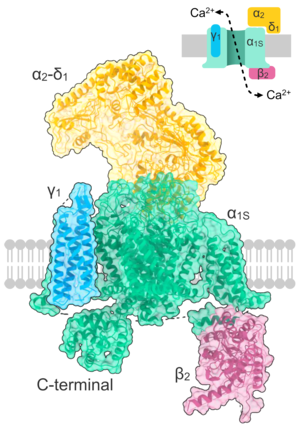| Calcium channel, voltage-dependent | |
|---|---|
 Crystallographic structure of the L-type calcium channel complex (subunits α1S, α2, δ, β, and γ). | |
| Identifiers | |
| Symbol | Calcium channel, voltage-dependent |


The L-type calcium channel (also known as the dihydropyridine channel, or DHP channel) is part of the high-voltage activated family of voltage-dependent calcium channel.[2] "L" stands for long-lasting referring to the length of activation. This channel has four isoforms: Cav1.1, Cav1.2, Cav1.3, and Cav1.4.
L-type calcium channels are responsible for the excitation-contraction coupling of skeletal, smooth, cardiac muscle, and for aldosterone secretion in endocrine cells of the adrenal cortex.[1] They are also found in neurons, and with the help of L-type calcium channels in endocrine cells, they regulate neurohormones and neurotransmitters. They have also been seen to play a role in gene expression, mRNA stability, neuronal survival, ischemic-induced axonal injury, synaptic efficacy, and both activation and deactivation of other ion channels.[3]
In cardiac myocytes, the L-type calcium channel passes inward Ca2+ current (ICaL) and triggers calcium release from the sarcoplasmic reticulum by activating ryanodine receptor 2 (RyR2) (calcium-induced-calcium-release).[4] Phosphorylation of these channels increases their permeability to calcium and increases the contractility of their respective cardiac myocytes.
L-type calcium channel blocker drugs are used as cardiac antiarrhythmics or antihypertensives, depending on whether the drugs have higher affinity for the heart (the phenylalkylamines, like verapamil), or for the blood vessels (the dihydropyridines, like nifedipine).[5]
In skeletal muscle, there is a very high concentration of L-type calcium channels, situated in the T-tubules. Muscle depolarization results in large gating currents, but anomalously low calcium flux, which is now explained by the very slow activation of the ionic currents. For this reason, little or no Ca2+ passes across the T-tubule membrane during a single action potential.
- ^ a b Felizola SJ, Maekawa T, Nakamura Y, Satoh F, Ono Y, Kikuchi K, et al. (October 2014). "Voltage-gated calcium channels in the human adrenal and primary aldosteronism". The Journal of Steroid Biochemistry and Molecular Biology. 144 Pt B (part B): 410–416. doi:10.1016/j.jsbmb.2014.08.012. PMID 25151951. S2CID 23622821.
- ^ Rossier MF (2016). "T-Type Calcium Channel: A Privileged Gate for Calcium Entry and Control of Adrenal Steroidogenesis". Frontiers in Endocrinology. 7: 43. doi:10.3389/fendo.2016.00043. PMC 4873500. PMID 27242667.
- ^ Cite error: The named reference
Lipscombe_2004was invoked but never defined (see the help page). - ^ Yamakage M, Namiki A (February 2002). "Calcium channels--basic aspects of their structure, function and gene encoding; anesthetic action on the channels--a review". Canadian Journal of Anaesthesia. 49 (2): 151–164. doi:10.1007/BF03020488. PMID 11823393.
- ^ Hughes A (2017). "Calcium channel blockers". In Bakris G, Sorrentino M (eds.). Hypertension: a companion to Braunwald's heart disease (Third ed.). Philadelphia, PA: Elsevier Health Sciences. pp. 242–253. ISBN 9780323508766. OCLC 967938982.